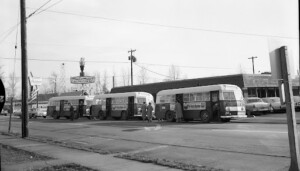Buses In Salem: A Process of Maturation (1927-1979)
Records and recollections are sparse or non-existent for the period between 1927 and 1979. Anecdotal information suggests that during part of the 1930s the buses were operated by a subsidiary of Greyhound Lines. By 1946 Oregon Motor Stages was operating the bus systems in both Salem and Eugene. The owner of Oregon Motor Stages might have been Barney Royce of Portland. The General Manager in both Salem and Eugene might have been Carl Wendt. In Salem the buses ran from 6:15 am to 12:15 am Monday through Saturday and 8:15 am to midnight on Sunday. These were the days before and after World War II when people did not own cars and could not get gasoline or tires even if they had owned an auto. Service extended to outlying towns. One bus traveled to Silverton and one to Falls City. In both cases the driver stayed overnight and brought the bus back to Salem with a full load the next morning.
Throughout the ’50s the buses were operated on a contract with a private operator. The adult fare was six cents. City Transit went bankrupt in 1959 and was sold to the bus operators and mechanics operating as Capitol Transit until 1966 when by public vote it was decided that transit service should be absorbed by the City of Salem. During this time separate small bus companies, some only one or two person operations, provided service in West Salem and in a loop around the outlying districts of Salem. When Oregon Motor Stages determined to take over an independent, suburban loop route which was operated by Dwight Wyatt during the late ’40s they ran a bus five minutes ahead of the existing bus and forced it out of business. Robert Covert and his wife drove one route in West Salem for many years with each driving nine-hour shifts. The West Salem route merged into Capitol Transit in 1963 or 1964. Salaries were low and it was not uncommon for drivers to work seventy hours per week.
The name “Cherriots’ was chosen from an entry by Kenneth Yost in a “Nickname Your City Bus” contest. Mr. Yost was awarded a $50.00 gift certificate.
New buses were purchased and, with much hope and fanfare, upgraded service was begun. The first Transit Superintendent for the City of Salem was A. R. Hampton who was appointed in 1966. His background was in the trucking industry.
These were turbulent times with the nation engulfed in the Vietnam War, severe gasoline shortages from time to time, and the continuation of dependency on the private automobile which had been heavily promoted after World War II. Public transit nationwide suffered through a severe decline as suburbanization and the movement away from centralization of services took hold. When Senate Bill 100, calling for the establishment of urban growth boundaries, was passed during the administration of Governor Tom McCall Oregon began the road away from uncontrolled growth. With many advances and retreats the concept has held through the year 2000. Oregon is nationally recognized as a leader in urban planning.
Growth of transit in Salem during the ’70s was slow. In 1976 the system had 22 buses, carried 3500 rides per weekday, and 1200 rides on Saturday. The adult fare was thirty cents. In those years it became apparent that public transit needed to be a separate entity, with its own funding and administration. It had to be able to go to the voters and present its needs without having to compete with the other services for which the City was responsible. After several attempts to get public approval the Salem Area Mass Transit District was formed.
Compiled by Clarence Pugh, Salem Area Transit
Bibliography:
Pete Lorensen, Salem Area Transit Operator and Operations Superintendent. July 2000 interview.
Arthur “Doug” Johnson, Salem Area Transit Operator. July 2000 interview.
John Whittington, Director of Transit Services, Salem Area Transit. July 2000
This article originally appeared on the original Salem Online History site and has not been updated since 2006.








Leave A Comment